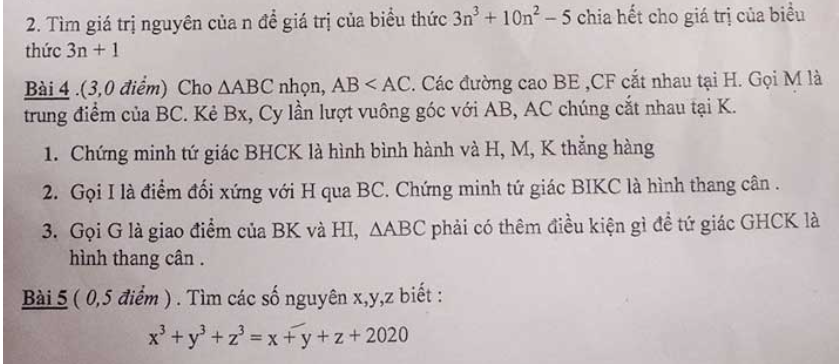
Hãy nhập câu hỏi của bạn vào đây, nếu là tài khoản VIP, bạn sẽ được ưu tiên trả lời.


Hợp chất tạo nên bởi 1 nguyên tử nguyên tố Y liên kết với 2 nguyên tử O.
Do vậy hợp chất có dạng: YO2
MYO2=Y+16.2=Y+32MYO2=Y+16.2=Y+32
→%mO=16.2Y+32=50%→Y=32(u)→%mO=16.2Y+32=50%→Y=32(u)
Vậy Y là S (lưu huỳnh).
Suy ra :
MSO2=32+16.2=64(u)=MCuMSO2=32+16.2=64(u)=MCu
Phân tử chất này nặng bằng nguyên tử Cu.
Ta có :
NTK2O = 16 * 2 = 32 (đvC)
=> NGUYÊN TỬ KHỐI của hợp chất trên là :
32 : 50% = 64 (đvC)
Do trong hợp chất trên gồm nguyên tử Y liên kết với 2 nguyên tử Oxi
=> NTKhợp chất = NTKY + NTK2O
=> 64 đvC = NTKY + 32 đvC
=> NTKY = 32 đvC
=> Y là nguyên tố Lưu huỳnh ( S )

bn mua cuốn sách ( GTLN, GTNN) dành cho hs thcs của ts toán học nguyễn cảnh toàn, đảm bảo bài nào cũng làm dc
tui dạy bn nhé ( pp thêm bớt)
vd tim gtln của 4x - x2 + 7 chẳng hạn
= -(x2- 4x -4+4) +7 = - (x-2)2 +4 +7
GTLN = 11

Theo đề bài t có : A=5/3.B
=>A+B=5/3.B +B=64
=>8/3.B=64
=>B=24
=> A=40
Vậy A là Canxi, kí hiệu Ca
ta co A+B=64
ma A = 5/3B
nen 5/3B+B=64
B(5/3+1)=64
B=64:8/3=24
A=24*5/3=40
suy ra A la canxi
B la magie

b,\(4x^2-20x=0\)
⇔\(4x\left(x-5\right)=0\)
⇔\(\left\{{}\begin{matrix}4x=0\\x-5=0\end{matrix}\right.\)
⇔\(\left\{{}\begin{matrix}x=0\\x=5\end{matrix}\right.\)
c,\(\left(3x-2\right)\left(4x+5\right)=0\)
⇔\(\left\{{}\begin{matrix}3x-2=0\\4x+5=0\end{matrix}\right.\)
⇔\(\left\{{}\begin{matrix}x=\dfrac{2}{3}\\x=-1.25\end{matrix}\right.\)
e,\(\left(x^2+1\right)\left(x-2\right)=0\)
⇔\(\left\{{}\begin{matrix}x^2+1=0\\x-2=0\end{matrix}\right.\)
⇔\(\left\{{}\begin{matrix}x^2=-1\left(loai\right)\\x=2\left(nhan\right)\end{matrix}\right.\)
⇔\(x=2\)
a) Ta có: \(\dfrac{x-3}{2011}+\dfrac{x-2}{2012}=\dfrac{x-2012}{2}+\dfrac{x-2011}{3}\)
\(\Leftrightarrow\dfrac{x-3}{2011}+\dfrac{x-2}{2012}-\dfrac{x-2012}{2}-\dfrac{x-2011}{3}=0\)
\(\Leftrightarrow\dfrac{x-3}{2011}-1+\dfrac{x-2}{2012}-1-\dfrac{x-2012}{2}+1-\dfrac{x-2011}{3}+1=0\)
\(\Leftrightarrow\dfrac{x-2014}{2011}+\dfrac{x-2014}{2012}-\dfrac{x-2014}{2}-\dfrac{x-2014}{3}=0\)
\(\Leftrightarrow\left(x-2014\right)\left(\dfrac{1}{2011}+\dfrac{1}{2012}-\dfrac{1}{2}-\dfrac{1}{3}\right)=0\)
mà \(\dfrac{1}{2011}+\dfrac{1}{2012}-\dfrac{1}{2}-\dfrac{1}{3}\ne0\)
nên x-2014=0
hay x=2014
Vậy: S={2014}
b) Ta có: \(4x^2-20x=0\)
\(\Leftrightarrow4x\left(x-5\right)=0\)
\(\Leftrightarrow\left[{}\begin{matrix}x=0\\x-5=0\end{matrix}\right.\Leftrightarrow\left[{}\begin{matrix}x=0\\x=5\end{matrix}\right.\)
Vậy: S={0;5}
c) Ta có: \(\left(3x-2\right)\left(4x+5\right)=0\)
\(\Leftrightarrow\left[{}\begin{matrix}3x-2=0\\4x+5=0\end{matrix}\right.\Leftrightarrow\left[{}\begin{matrix}3x=2\\4x=-5\end{matrix}\right.\Leftrightarrow\left[{}\begin{matrix}x=\dfrac{2}{3}\\x=-\dfrac{5}{4}\end{matrix}\right.\)
Vậy: \(S=\left\{\dfrac{2}{3};-\dfrac{5}{4}\right\}\)
d) Ta có: \(\dfrac{x-5}{75}+\dfrac{x-2}{78}+\dfrac{x-6}{74}+\dfrac{x-68}{12}=4\)
\(\Leftrightarrow\dfrac{x-5}{75}-1+\dfrac{x-2}{78}-1+\dfrac{x-6}{74}-1+\dfrac{x-68}{12}-1=0\)
\(\Leftrightarrow\dfrac{x-80}{75}+\dfrac{x-80}{78}+\dfrac{x-80}{74}+\dfrac{x-80}{12}=0\)
\(\Leftrightarrow\left(x-80\right)\left(\dfrac{1}{75}+\dfrac{1}{78}+\dfrac{1}{74}+\dfrac{1}{12}\right)=0\)
mà \(\dfrac{1}{75}+\dfrac{1}{78}+\dfrac{1}{74}+\dfrac{1}{12}>0\)
nên x-80=0
hay x=80
Vậy: S={80}
e) Ta có: \(\left(x^2+1\right)\left(x-2\right)=0\)
mà \(x^2+1>0\forall x\)
nên x-2=0
hay x=2
Vậy: S={2}

chứng minh đó bạn tại cô giáo mình hay viết thế nên quen giúp mình nha

Bài 2:
Ta có: \(3n^3+10n^2-5⋮3n+1\)
\(\Leftrightarrow3n^3+n^2+9n^2+3n-3n-1-4⋮3n+1\)
\(\Leftrightarrow3n+1\in\left\{1;-1;2;-2;4;-4\right\}\)
\(\Leftrightarrow3n\in\left\{0;-3;3\right\}\)
hay \(n\in\left\{0;-1;1\right\}\)
